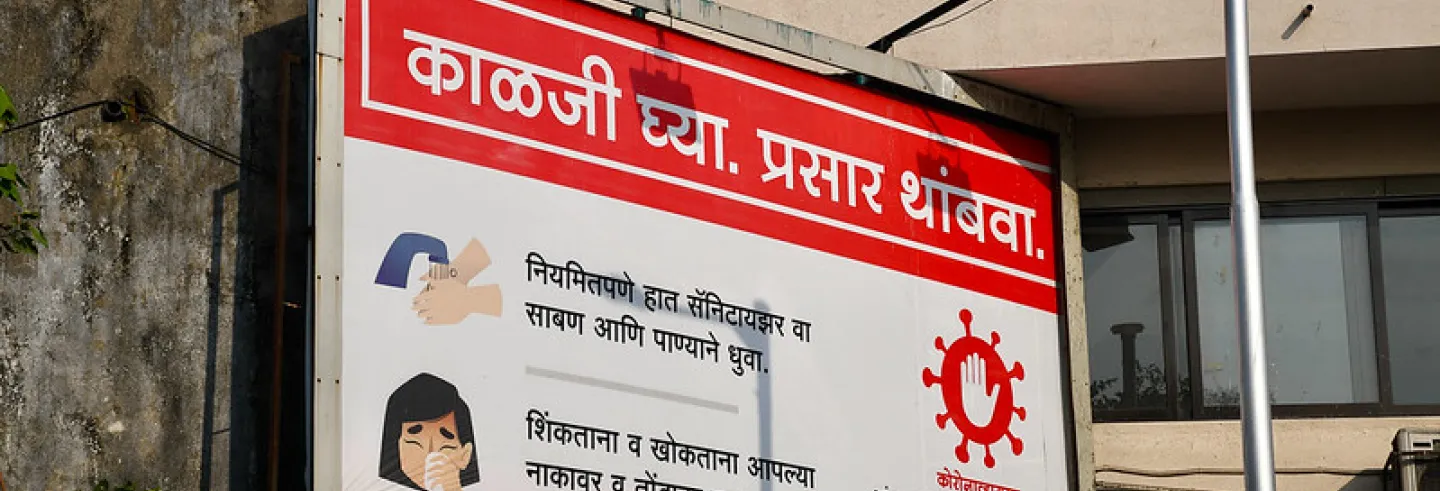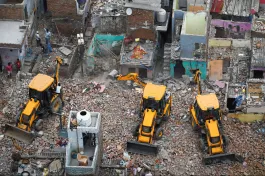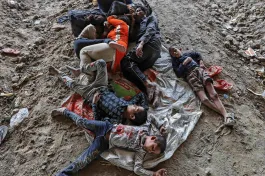The Covid-19 pandemic has exposed fault lines in an Indian public health system that has suffered from years of underinvestment, poor infrastructure, and shortage of human resources.
Mumbai itself has one of the best health infrastructures in the country with tertiary hospitals, peripheral hospitals, infectious diseases hospitals, maternity homes, and dispensaries. During the first wave, the Municipal Corporation of Greater Mumbai (MCGM) spent Rs. 610 crore from its health budget on tackling the pandemic.
Mumbai’s 18 peripheral hospitals form the backbone of multi-speciality care for the city’s increasing suburban population but they have remained neglected for years. They saw the addition of more than 500 beds dedicated to Covid-19 patients in June 2020. Although Maharashtra mandated that 80% of private beds would be reserved for Covid-19 patients, hospitalised care during the first wave was largely carried out by public institutions. Despite measures such as capping the cost of beds, ground-level experience suggests that private hospitals resort to unethical practices. An audit of 1,100 bills by the MCGM during the first wave showed blatant overcharging by private hospitals and resulted in a refund of about Rs. 15 crore to patients.
The preparedness of Mumbai hospitals to respond to a pandemic during the first phase strengthened its response in subsequent periods…
To recognise the centrality of the public health system in providing effective and affordable healthcare, it is important to bring the response of public hospitals during the pandemic and the challenges faced by their staff to the public domain. Further, the preparedness of Mumbai hospitals to respond to a pandemic of this nature during the first phase strengthened its response in subsequent periods of time. While we have not examined the responses of the public health department or tertiary care, this study’s findings point to the health department having adopted a comprehensive and dynamic approach.
The Centre for Enquiry into Health and Allied Themes (CEHAT), which has had a long association with public hospitals in the metropolis, carried out an inquiry into their preparedness, functionality, and experiences during the first wave of the pandemic in Mumbai. Both their good practices and the problems they faced while providing services were also looked into. CEHAT provides technical support to 11 peripheral hospitals through capacity building for responding to violence against women cases by running Dilaasa centres (Dilaasa centres are hospital-based crisis intervention centres for survivors of violence under the National Urban Health Mission. These centres are located in 11 peripheral hospitals).
Healthcare providers (HCPs) from both peripheral and tertiary hospitals were contacted for a rapid assessment. However, HCPs from tertiary hospitals were not available due to the burden of care in specialised hospitals. Thus, the assessment through telephonic interviews was carried out with 21 staff members (10 doctors, five sisters in charge, three staff nurses, and three community development officers) from 13 of the 18 peripheral hospitals between May and June 2020.
Readiness of hospitals
In the beginning, Covid-19 cases were handled by the Corporation-run infectious disease hospital. With an increase in the number of cases in March, four peripheral hospitals were equipped to cater to confirmed and suspected cases. In April, other peripheral hospitals also began receiving patients with Covid-19 symptoms. Although there was no official notification, these hospitals made arrangements to provide services to walk-in Covid-19 patients. At the time of the survey, seven of the 13 peripheral hospitals were dedicated hospitals, four provided treatment to Covid-19 patients with mild to moderate symptoms, and two were for non-Covid-19 cases. Dedicated peripheral hospitals catering to seriously ill Covid-19 patients were at the top of the MCGM’s three-tier care system by, followed by dedicated Covid-19 care centres.
Preventing the transmission of infection was a tedious task as much of the hospital facilities were not constructed or designed to handle infectious diseases.
The focus was to prevent transmission of infection, modify the existing space, manage the workforce, and enhance the capacity of providers. This was a tedious task as facilities were not constructed or designed to handle infectious diseases. The measures to stop the chain of transmission included a single entry to ensure the screening of all patients, the setting up of a Covid-19 outpatient department (OPD) closer to the hospital gate, dedicating a floor to Covid-19 services, and assigning separate lifts, X-ray machines, and ambulances to pandemic patients.
The space for creating the Covid-19 wards and for donning and doffing personal protective equipment (PPE) was found by converting departments that were closed due to Covid-19, for example, ENT (ear, nose, throat). Preparations for Covid-19 wards included equipping toilets with geysers, creating space for sanitisation and centralised oxygen lines, providing hot drinking water to patients, and relocating functional departments.
Only providers of hospitals that were declared as Covid-19 facilities reported attending any training. The selected hospital administrators were trained, and they in turn instructed the rest of their staff. The training included information about Covid-19, its transmission, the safety measures to undertake, the disposal of hospital waste and other procedures to be followed the institution.
The staff of departments that were closed was absorbed into Covid-19 work. Those who were at high risk or had any co-morbidities were not assigned Covid-19 duties. Some of the hospitals also welcomed volunteers from the Indian Medical Association (IMA) and from among AYUSH (Ayurveda, Yoga and Naturopathy, Unani, Siddha, and Homeopathy: the six systems of medicine prevalent and practised in India) doctors to manage the shortage of providers.
Provision of Covid-19 care
Seven of the dedicated Covid-19 facilities were involved in the efficient triage of patients. The providers in rest of the hospitals implemented an effective referral system. Providers in PPE checked the patient’s signs and symptoms and took swabs in suspected cases. Initially, samples were sent to a testing facility and it would take at least five days for the results. Meanwhile, suspected patients would be admitted to the hospital. However, over time, facilities were either equipped to analyse samples on-site or were linked to private laboratories to enable test results to be obtained within a day or two. Providers reported that with increased awareness, many pregnant women came to hospitals with their Covid-19 test done.
Hospitals that were not designated as Covid-19 facilities modified their services to care for patients, even when the resources they needed had not been received.
The state authorities kept changing the protocols for managing patients, especially with regard to admitting them to hospitals, Covid-19 care centres, and home quarantine. This made it difficult for providers to keep up with the changes. For critically ill patients, the directive was to refer them to higher tertiary facilities through hospital ambulance services and/or through the 108 ambulance service. Life-saving drugs were made available in higher facilities. Some of the hospitals also worked with private ambulance providers to address the increase in demand. Due to a shortage of providers, only critical patients were accompanied by a doctor who sat along with the driver to avoid infection from the patient. This was reportedly a taxing procedure as it required coordination with the higher centre.
The hospitals that were not designated as Covid-19 facilities modified their services to care for positive patients, even when the resources they needed had not been allocated to them. These hospitals provided symptomatic treatment and oxygen therapy to patients because beds at higher facilities were not available all of the time. Some of the smaller hospitals where intensive care unit (ICU) facilities were not regularly available, opened ICU facilities with the deployment of intensive care providers.
For instance, one hospital did not have an ICU when it received calls about a patient with severe breathing problems. Realising that the patient had been turned away from elsewhere, the hospital staff borrowed ventilators and other equipment from a nearby facility and opened their first bed for positive Covid-19 patients in the ICU. This grew to 22 beds in a still undeclared Covid-19 ICU, all managed by four interventionists.
The Covid-19 treatment was offered free of cost. The charges for ICUs and CT scans were also waived for such patients. One hospital initiated the provision of a kit to increase the comfort of their Covid-19 patients. This kit included items of daily use with a message of “get well soon” with a smiley on it. Later, the hospital was able to procure donations for these kits. Hospitals also benefitted from donations in the form of juice boxes, personal care kits, and vapourisers for patients to inhale steam. Providers reported being covered by the MCGM for free treatment within their hospitals and even having the option of moving to a higher facility if their own did not have a vacancy.
Provision of non-Covid-19 care
During the Covid-19 pandemic, several patients who had not been attacked by the virus faced difficulties in accessing care. Providers also reported that there was a decrease in patient footfalls for non-Covid-19 care both because of fear among people and because of lockdown restrictions. Hospitals reported shutting down either all major OPDs or keeping only the essential OPDs functional. The OPDs that were open varied between facilities, and included ART (antiretroviral therapy), TB (tuberculosis), gynaecology, ANC (antenatal care), paediatric, immunisation, medicine, and surgery.
However, at several small hospitals, these facilities were closed and patients were referred to other hospitals. Notably, in all the hospitals, critical patients were given the first-line of treatment before referral. Ambulances were only used for the transfer of Covid-19 patients and non-Covid-19 patients were asked to access services on their own.
The labour ward was functional in all hospitals and some of them reported doing more C-sections due to referrals from other hospitals.
Regular ANC was suspended in most of the hospitals and women were asked to seek follow-up treatment at health posts and corporation dispensaries closer to their homes. In some hospitals where ANC services continued, only high-risk patients were encouraged to come. The labour ward was functional in all hospitals and some of them reported doing more C-sections due to referrals from other hospitals. Some of the hospitals even reported doing C-sections without a Covid-19 report by following universal precautions. Medical termination of pregnancy (MTP) services were suspended across all hospitals. However, it was provided to women who reached the hospital with a complaint of vaginal bleeding.
In addition, the Dilaasa centres were declared as essential services by the MCGM. Hospitals where the casualty department was open to all patients saw cases of domestic and sexual violence, which were attended to by the Dilaasa staff. In cases where all OPDs were shut down, Dilaasa was also closed until the Deputy Executive Health Officer intervened. From March to May, 150 cases of survivors reached these centres for seeking support services, though the footfall was much less. The more severe cases such as assaults, suicide attempts, rape, and child sexual abuse reached hospitals and Dilaasa could address these issues.
There was varied availability of routine diagnostic services. Some facilities also outsourced tests such as those for C-reactive protein (CRP) and prognostic markers like lactate dehydrogenase (LDH) to private labs. HCPs reported that the patients were often sent back as many of the private labs had closed down or demanded higher charges. Only one facility reported having functional dialysis services while others had to refer patients to tertiary hospitals. While the blood banks were all functional and even carried out blood donation camps, the outsourced services were not available or accessible to all patients. All elective surgeries were suspended.
A TB OPD was functional in most of the hospitals and patients were asked to follow up on a toll-free number. In one hospital, a person was designated to call all the TB patients and inform them about the functional OPD. The medicines to diabetic and hypertensive patients were provided for a greater number of days to reduce their visits to hospitals for procuring medicines. One of the hospitals reported providing psychiatric services thrice a week whereas another hospital had psychiatrists on call.
Managing human resources
The shortage of staff was exacerbated during the pandemic. Hospitals also had to deploy their staff to isolation and quarantine facilities in their vicinity.
Initially, there was a sense of fear among HCPs of all cadres. Due to this, hospitals experienced widespread absenteeism among the Class 4 staff who felt that their safety concerns were not being taken into account. Efforts were made to counsel them, and ensure the provision of PPE and accommodation for them. The nature of protection gear differed according to the role of the provider and his or her contact with the patient. The fear was so high that this was not understood by all and a lot of staff members felt that they were not equipped adequately.
The protocol for isolation for seven days after Covid-19 duty for care providers was impossible to follow because of the lack of human resources.
Initially, hotel facilities were made available only for doctors and nurses, which were later extended to Class 4 employees as well. Also, providers reported that the insurance coverage announced by the Maharashtra government was extended to only certain staff members while others were at risk. Hospitals reported hiring contractual Class 4 workers for the handling of dead bodies and for cleaning and disinfection-related work. The protocol for isolation for seven days after Covid-19 duty for HCPs was a concern as it was impossible to follow given the lack of human resources.
Problems faced by female health workers
A common concern of hospitals not dedicated to Covid-19 care was access to protective gear. This was problematic for the safety of providers as they were still coming in contact with Covid-19 cases and needed the same amount of safety measures and testing facilities for their staff. Besides, female HCPs faced a variety of issues due to wearing PPE.
It caused discomfort during menstruation and several providers reported developing a body rash because of layered clothing. Nurses fainted because they were initially required to wear the kit over their uniforms. This was rectified by ordering vests and pyjamas for the nurses. In one of the hospitals, wrap-around PPE kits were arranged for women sweepers through a donation. Further, many female providers reported a double burden due to increased work at hospitals and additional care work at home.
Public hospitals with limited resources and many challenges were at the forefront of providing healthcare during the first wave and continued to do so during the second wave.
During the lockdown, commuting to the workplace was a challenge for providers. The hotel stay was optional and many providers had to continue travelling. Buses dropped them on the highway and many providers had to walk for an hour or an hour and a half. The medical superintendent of one of the hospitals arranged three buses to transport the staff.
Mental health of patients
An important aspect of ensuring the well-being of Covid-19 patients was shared by providers. In a hospital, a community development officer (CDO) along with a volunteer counsellor boosted the morale of patients by visiting them regularly and engaging with them in various activities. They visited the ward in PPE kits with a megaphone and counselled patients to stay positive. In some cases, the CDO asked doctors on duty to talk to patients in distress. The doctors, paying attention to their concerns, spent time with patients, thus boosting their morale.
Health care providers had concerns about the lack of acknowledgement and appreciation of their hard work. They gave examples of how relatives of patients did not understand their problems and the conditions under which they were working. In some of the hospitals, CDOs were involved in addressing the queries of patients and their relatives. This often helped avoid any miscommunication between the hospital and family members of patients.
Conclusions
The MCGM has been applauded for its Dharavi model and the Supreme Court has appreciated how the Mumbai model responded to the second wave of Covid-19. The second wave was characterised by a high number of patients needing hospitalisation, which required triage as well as a centralised system for ensuring access to treatment. As reported in the study, several of these critical elements were part of the preparedness itself— such as triage of patients at hospitals, being cognisant of non-Covid-19 care, taking steps towards ensuring provision of essential services, and involving the private health sector. In doing so, the safety and concerns of hospital staff through provision of PPE, accommodation, and food were taken on board.
We have to consider the role of the private sector as one that supplements the strengths of the public sector rather than substitute for them.
Public hospitals with limited resources and many challenges were at the forefront of providing healthcare during the first wave and continued to do so during the second wave. Outsourcing of diagnostic services on a public-private partnership (PPP) model has been followed by the MCGM for several years and this survey highlighted how these facilities were not available during the pandemic. The lack of regulation of the private sector has emerged as a major concern with most of them closing down their services, including the ones that they were providing through a PPP with the government.
The pandemic has brought with it an important opportunity to bring substantial changes in our public healthcare system. One of the most important learnings is the need to nurture public health facilities because they have proven to be irreplaceable. We have to consider the role of the private sector as one that supplements the strengths of the public sector rather than substituting for them. The survey also highlighted the critical role of hospital staff across all cadres in innovating and responding to a public health crisis.
We acknowledge the contributions of all the researchers from CEHAT who contributed to this survey at various stages—Anagha Pradhan, Padma Bhate-Deosthali, Sangeeta Rege, Sanjida Arora, and Surbhi Shrivastava.









